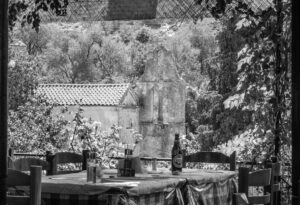Fotini, Kaminaki, Corfu, 28th August 2005
We drove north to Kalami, Kassiopi and up to Ano Perithia (sometimes signed as ‘Old’, I prefer ‘Ano’). The road from Loutses has been much improved since we visited in 2001, widened and surfaced, though the last stretch into the village is still rugged.
Ano Perithia is largely a ruin. Derelict houses become sources of romantic fascination and speculation: outside and inside staircases go nowhere; crumbling walls barely support roofs and ceilings that have fallen in; broken shutters and shelves hang forlornly on rusted hinges and brackets; bed frames lurch precariously in voids over missing floors; an old shop counter stands deserted waiting for customers that never come. Nature has taken over. In this decay there are signs of a once prosperous community – spacious rooms, grand doorways, decorative stonework, delicately molded inner wooden door frames and several crumbling churches.
But it is changing. On the last visit there were three cars parked at the end of the road, today a dozen. Then there were no shops, now there is one serving the trickle of visitors; then there was one taverna, now there are four, one with an annex selling olive wood bowls; then barely a handful of properties renovated, now a dozen and a pristine church and villas on the valley side. All or some of it done with the benefit of funding from an EU LEADER project. Some properties, little more than ruined shells, carry optimistic ‘For Sale’ signs.
We followed rough arrows along indistinct, branching paths to a farmer selling honey. With a sweep of his arm he proudly embraced 65 hives set among the trees climbing the hillside, saying that the bees are not busy at the moment as there are few flowers about until the September rains. We bought a comb of thyme honey for 15 Euro; beautiful sleek blue-eyed cats prowled around our legs.
Lunch at the Old Perithia Taverna, a shady haven on the square. Half way through our kleftiko a jeep safari arrived from the mountain roads to the south, 10 vehicles and 40 people, mainly Germans and French, who filled the place, no longer the haven it was.
So, tourism is playing a part in driving the future of Ano Perithia; also lifestyle choices by those escaping to the mountains. It prompts questions: who lived here and why was it abandoned? There is irony in the answer.
Perithia was built in the 14th century when the island was under Byzantine rule. The surrounding land was ideal for both sheep farming and the cultivation of olives and vines and the village prospered. It was also a hideaway from pirate attacks on the coast. One of the wealthiest communities on the island, by the mid-17th century there were 130 houses of Venetian origin and eight churches. Times were harder in rural Greece by the 20th century, however. As tourism began to bring wealth and plentiful easier jobs to Corfu’s coasts in the 1960s, the village’s residents were drawn down the mountain in search of work leaving the village to nature. The wheel turns.

